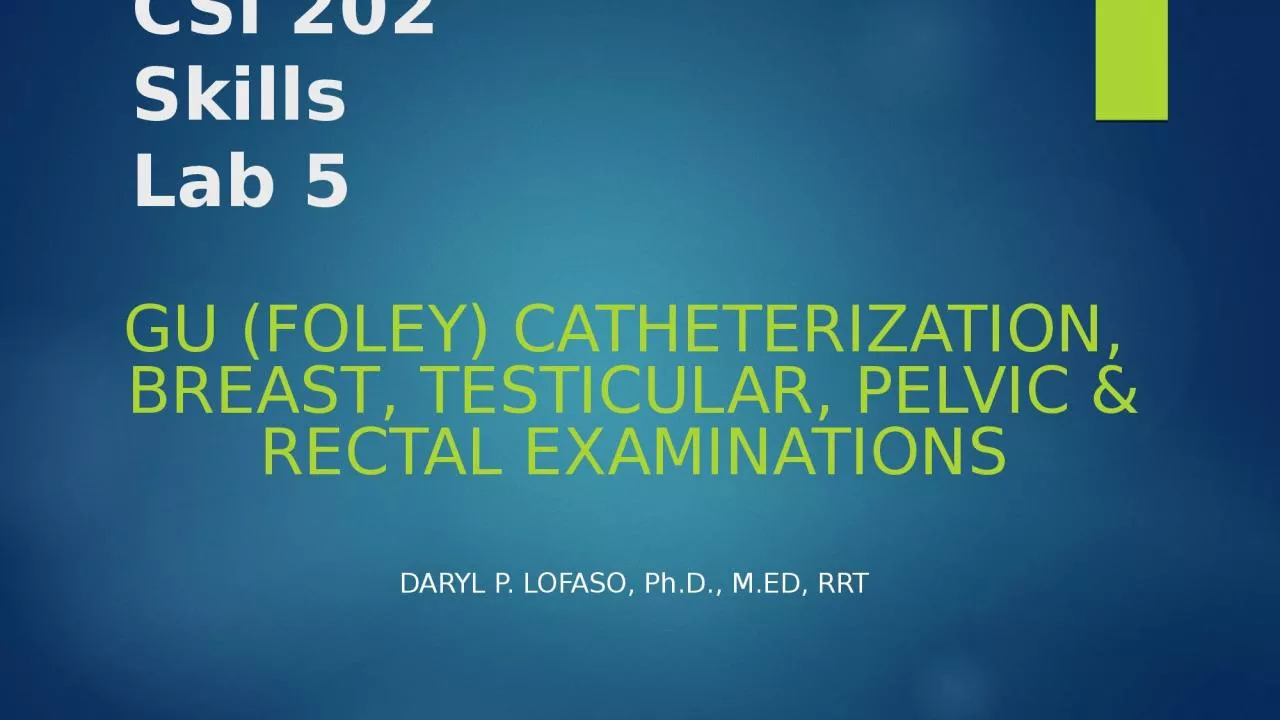

Daryl P Lofaso P h D MEd RRT Urethral Catheterization Indications Long Term Refractory bladder outlet obstruction Neurogenic bladder with urinary retention Complications of incontinence ID: 1041368
Download Presentation The PPT/PDF document "CSI 202 Skills Lab 5 GU (Foley) Cathete..." is the property of its rightful owner. Permission is granted to download and print the materials on this web site for personal, non-commercial use only, and to display it on your personal computer provided you do not modify the materials and that you retain all copyright notices contained in the materials. By downloading content from our website, you accept the terms of this agreement.
1. CSI 202 Skills Lab 5GU (Foley) Catheterization, Breast, Testicular, Pelvic & Rectal ExaminationsDaryl P. Lofaso, Ph.D., M.Ed, RRT
2. Urethral CatheterizationIndicationsLong TermRefractory bladder outlet obstructionNeurogenic bladder with urinary retentionComplications of incontinenceSkin breakdownTerminally illShort TermUrologic or pelvic surgeryAcute urinary retentionUrinary output monitoring in critically ill
3. Anatomic Landmark for Female Catheterization
4. Female Cath: Hand positions
5. Male CatheterizationUncircumcised male -pull foreskin backVisualize the meatusMaintain hand position throughout procedure
6. Nosocomial UTI80% associated w/urinary cathetersCommon OrganismsE. coliEnterococcus species*Pseudomonas aeruginosa*Candida albicans* Antibiotic resistance may lead to increased morbidity
7. Pelvic ExaminationIndications:Physical ExamAbdominal painPelvic painYearly screening (pap smear)
8. Breast ExaminationIndications:Physical ExamBreast PainLumpsBreast Development- adolescent
9. Breast CANCI recommends mammograms every 1-2 years at 40 yrs. of ageMammograms yearly at age 50Mammograms as early as 25 yrs. of age for pt. with high risk of breast CAStudies suggest Breast CA could be cut by 36-44% if mammography performed annually
10. Breast CA - StatisticsIn 20211 in 8 U.S. woman (about 13%) will develop breast cancer over the course of her lifetime. 281,550 women in the US were diagnosed with breast cancer43,600 women in the US died from breast cancer2,650 new cases of invasive breast cancer are expected to be diagnosed in men.https://www.breastcancer.org/symptoms/understand_bc/statistics
11. Rectal ExaminationIndications:Physical ExamAbdominal painRectal painUrogenital dysfunction (complaints)Screening for Colon CA and Prostate CA
12. Prostate Examination
13. Charting: Rectal ExaminationTone – normal, decrease or absentMassesStool color, Hemoccult examination of stoolProstate – size, texture
14. Prostate CAAbout 1 in 8 diagnosed with prostate cancer during his lifetime.2nd leading cause of death in American men (1 in 41)Only 3 men in 100 will actually die of itFamily History - ↑ riskAfrican American men: very high riskHigh fat diet associated with ↑ risk
15. Testicular ExaminationIndications:Physical ExamUrologential dysfunction (complaints)
16. Testicular CAIncidence of testicular cancer is low, about 1 of every 250 malesAverage age: 33 yrs.Lifetime risk: 1 in 5,000Testicular Self-examination (TSE)https://www.cancer.org/cancer/testicular-cancer/about/key-statistics.html
17. Professional ConductIntroduce yourselfExplain the procedure/exam to pt.Ask pt. if they have any questionsCover pt. with a sheet. Only expose area which you are examining, then cover againWhile performing the procedure/exam, explain to the pt., you may or may not be some discomfort associated with the exam, but you will be as gentle as possible.